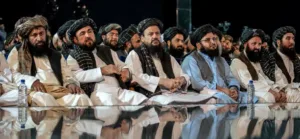Secretary of Defense James Mattis met with the Senate Armed Forces committee yesterday. A portion of the discussion involved measures to break the seeming stalemate in Afghanistan, particularly in light of President Trump’s August speech outlining his strategy for the region. A much-vaunted element of the administration’s approach is the replacement of time constraints with a conditions-dependent approach that considers context—rather than calendar—as the key component to decision-making.
One key aspect of this is the ability of US, Afghan, and allied warfighters to fight to win. Mattis reported, “While we continue to make gains against the terrorist enemy in Syria, Iraq and elsewhere, in Afghanistan we have faced a difficult 16 years.” The secretary added that the new strategy permits US military greater freedom and gives them increased resources to improve conditions on the ground and for putting in place Afghan forces that can protect their fellow citizens, and maintain order, justice, and peace.
One aspect of Mattis’ testimony that has received attention is the loosening of US rules of engagement—those directives that govern the circumstances, conditions, degree, and manner in which the use of force can be applied against enemy forces.
A primary change involves being able to attack enemy forces regardless of how geographically proximate they happen to be to US forces or coalition partners. As Mattis explained to the committee, “It used to be we have to basically be in contact with that enemy.” From now on, Mattis continued, “werever we find them, anyone who is trying to throw the NATO plan off, trying to attack the Afghan government, then we can go after them.” The new policy allows commanders on the ground to assess tactics based on conditions, experience, and common sense to determine whether someone is an enemy. “If they are in an assembly area, a training camp, we know they are an enemy and they are going to threaten the Afghan government or our people,” Mattis pointed out.
The second major change regarding engagement rules is the new allowance for dispersing US military advisors among Afghan forces that are closer to the enemy. Previously, US forces were working alongside Afghan forces only at the headquarters level. They will be functioning at brigade and battalion levels, putting them in the heart of more decisive action. The makes a practical difference because US airpower requires US forces to call them in.
General Joe Dunford, Chairman of the Joint Chiefs of Staff, testifying alongside Mattis, explained that air power “wasn’t being delivered to those Afghan units most relevant in the fight because we didn’t [previously] have the authority to put advisers down in that level of the fight,” The change in policy, he added, “has, and…will, make us more effective.”
Taken together, these two changes in rules of engagement are invaluable. Mattis put it simply: “Those units with NATO and American advisers win, and those without them often do not win.” We are “now…able to bring this fire support to bear where we could not [before], whether it be for proximity or [because] we were not with those units. Because of this, the secretary concluded, “beginning last month, and for the first time in this long fight, all six Afghan military corps are engaged in offensive operations,”
All of this is to the good. I have stressed elsewhere the critical relationship between rules of engagement and moral injury. Good rules of engagement guide warfighters, in the time compression and high stress of combat, to fight justly. These two rule changes do nothing to jeopardize this value.
In fact, they improve the ability of US warfighters to fight justly. Rules of engagement aren’t designed only to put a leash on warfighters but, also, to show them when to shoot. They are both limit and spur. Moreover, they are designed not only to protect innocent noncombatants from being fired upon but, also, to protect US forces—giving them clear permission for when to engage. Unfortunately, US policymakers have too often unnecessarily burdened our front-line forces with foolish rules of engagement that protect neither US forces nor innocent civilians.
The issue is an old one. Just one example from my files, from 2010, written by a Marine Corps Times writer, discusses the frustration of rules of engagement that don’t allow for experience and common sense to dictate terms of fire:
Marines I went on patrol with in Afghanistan expressed dread over dealing with spotters, who observe Marines on patrol and drop back as they advance, only to disappear completely when nearby insurgents working in coordination with the spotters open fire. Since the spotters carry no weapons, Marines say they are not allowed to fire on them, even though their involvement in a pending attack is obvious. As one corpsman said…it always starts with “one guy pointing.”
In American Sniper, US Navy SEAL sniper, Chris Kyle, a member of the famous punishers, often lamented the absurd rules that barred him from using common sense to protect his fellow combatants. Too often, he would see armed fighting age males moving tactically toward US forces but would not be allowed to engage. This put not just US forces at risk but area civilians who might be caught up in high-volume crossfire—which might have been avoided with a single shot from a sniper rifle. Kyle wrote:
You cannot be afraid to take your shot. When you see someone with an IED or a rifle maneuvering toward your men, you have clear reason to fire. (The fact that an Iraqi had a gun would not necessarily mean he could be shot.) The ROEs were specific, and in most cases the danger was obvious.
So, these changes partially remedy old problems. And they do so by allowing us to fight more justly. This is especially true because a part of just war thinking includes recognizing the good of ending a conflict as quickly as possible. Of course, there’s a lot of content that needs to be unpacked in the term “possible.” Some of the content includes moral norms and justice. I don’t mean “possible” as in “anything goes” but rather “possible” in terms of “in so far as it is possible for you—given who you are, why you are fighting, and how you ought to fight.” The end of just war is peace. Peace is most often more easily acquired when fights can be quickly brought to an end. It’s easier on infrastructure, helps prevent deep reservoirs of resentment and a desire for vengeance to form, and allows the innocent to more quickly enjoy the goods of justice, order, and peace.
Rules of engagement are important, they ought to serve as both a spur for kinetic action as well as a limit to it. They ought to persevere the warrior’s moral compass and protect the warrior’s soul. But they must not unduly bind the warrior’s hands.
We mustn’t say “sic ‘em” and then refuse the leash sufficient slack.
In fixing two errors in the old rules, Secretary of Defense Jim Mattis, representing the administration, has done a good thing.
—
Marc LiVecche is managing editor of Providence
Image: Defense Secretary Jim Mattis testifies during a Senate Armed Services Committee hearing in Washington, D.C., Oct. 3, 2017. Mattis testified alongside Marine Corps Gen. Joe Dunford, chairman of the Joint Chiefs of Staff, about the political and security situation in Afghanistan. DoD photo by Army Sgt. James K. McCann







 Live in the DC area? Sign-up for Providence's in-person events list!
Live in the DC area? Sign-up for Providence's in-person events list!